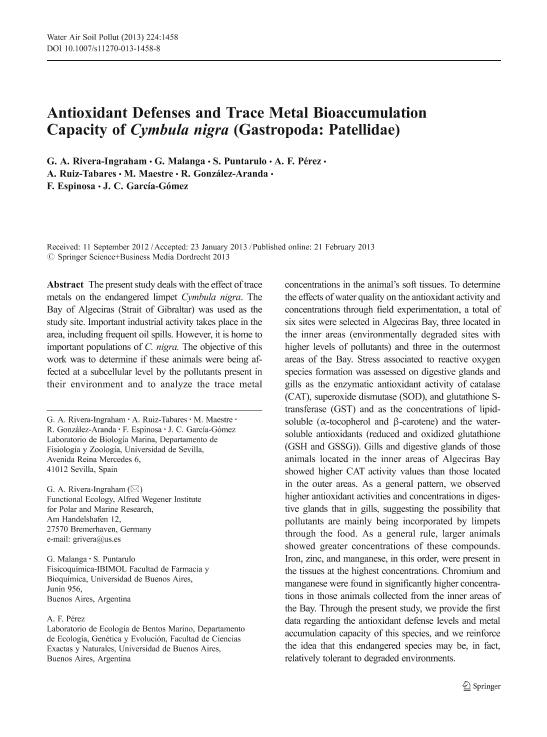Mostrar el registro sencillo del ítem
dc.contributor.author
Rivera Ingraham, G. A.
dc.contributor.author
Malanga, Gabriela Fabiana

dc.contributor.author
Puntarulo, Susana Ángela

dc.contributor.author
Pérez, A. F.
dc.contributor.author
Ruiz Tabares, A.
dc.contributor.author
Maestre, M.
dc.contributor.author
González Aranda, R.
dc.contributor.author
Espinosa, F.
dc.contributor.author
García Gómez, J. C.
dc.date.available
2017-07-26T17:43:05Z
dc.date.issued
2013-03
dc.identifier.citation
Rivera Ingraham, G. A.; Malanga, Gabriela Fabiana; Puntarulo, Susana Ángela; Pérez, A. F.; Ruiz Tabares, A.; et al.; Antioxidant defenses and trace metal bioaccumulation capacity of Cymbula nigra (Gasteropoda: Patellidae); Springer; Water, Air and Soil Pollution; 224; 3-2013; 1458-1471
dc.identifier.issn
0049-6979
dc.identifier.uri
http://hdl.handle.net/11336/21345
dc.description.abstract
The present study deals with the effect of trace metals on the endangered limpet Cymbula nigra. The Bay of Algeciras (Strait of Gibraltar) was used as the study site. Important industrial activity takes place in the area, including frequent oil spills. However, it is home to important populations of C. nigra. The objective of this work was to determine if these animals were being affected at a subcellular level by the pollutants present in their environment and to analyze the trace metal concentrations in the animal’s soft tissues. To determine the effects of water quality on the antioxidant activity and concentrations through field experimentation, a total of six sites were selected in Algeciras Bay, three located in the inner areas (environmentally degraded sites with higher levels of pollutants) and three in the outermost areas of the Bay. Stress associated to reactive oxygen species formation was assessed on digestive glands and gills as the enzymatic antioxidant activity of catalase (CAT), superoxide dismutase (SOD), and glutathione S-transferase (GST) and as the concentrations of lipid-soluble (α-tocopherol and β-carotene) and the water-soluble antioxidants (reduced and oxidized glutathione (GSH and GSSG)). Gills and digestive glands of those animals located in the inner areas of Algeciras Bay showed higher CAT activity values than those located in the outer areas. As a general pattern, we observed higher antioxidant activities and concentrations in digestive glands that in gills, suggesting the possibility that pollutants are mainly being incorporated by limpets through the food. As a general rule, larger animals showed greater concentrations of these compounds. Iron, zinc, and manganese, in this order, were present in the tissues at the highest concentrations. Chromium and manganese were found in significantly higher concentrations in those animals collected from the inner areas of the Bay. Through the present study, we provide the first data regarding the antioxidant defense levels and metal accumulation capacity of this species, and we reinforce the idea that this endangered species may be, in fact, relatively tolerant to degraded environments.
dc.format
application/pdf
dc.language.iso
eng
dc.publisher
Springer

dc.rights
info:eu-repo/semantics/openAccess
dc.rights.uri
https://creativecommons.org/licenses/by-nc-sa/2.5/ar/
dc.subject
Cymbula
dc.subject
Trace Metals
dc.subject
Limpet
dc.subject
Ros
dc.subject
Strait of Gibraltar
dc.subject
Subcellular Stress
dc.subject.classification
Biología Marina, Limnología

dc.subject.classification
Ciencias Biológicas

dc.subject.classification
CIENCIAS NATURALES Y EXACTAS

dc.title
Antioxidant defenses and trace metal bioaccumulation capacity of Cymbula nigra (Gasteropoda: Patellidae)
dc.type
info:eu-repo/semantics/article
dc.type
info:ar-repo/semantics/artículo
dc.type
info:eu-repo/semantics/publishedVersion
dc.date.updated
2017-07-25T14:59:49Z
dc.identifier.eissn
1573-2932
dc.journal.volume
224
dc.journal.pagination
1458-1471
dc.journal.pais
Países Bajos

dc.journal.ciudad
Dordrecht
dc.description.fil
Fil: Rivera Ingraham, G. A.. Universidad de Sevilla; España
dc.description.fil
Fil: Malanga, Gabriela Fabiana. Consejo Nacional de Investigaciones Científicas y Técnicas. Oficina de Coordinación Administrativa Houssay. Instituto de Bioquímica y Medicina Molecular. Universidad de Buenos Aires. Facultad de Farmacia y Bioquímica. Instituto de Bioquímica y Medicina Molecular; Argentina
dc.description.fil
Fil: Puntarulo, Susana Ángela. Consejo Nacional de Investigaciones Científicas y Técnicas. Oficina de Coordinación Administrativa Houssay. Instituto de Bioquímica y Medicina Molecular. Universidad de Buenos Aires. Facultad de Farmacia y Bioquímica. Instituto de Bioquímica y Medicina Molecular; Argentina
dc.description.fil
Fil: Pérez, A. F.. Universidad de Buenos Aires. Facultad de Ciencias Exactas y Naturales. Departamento de Ecología, Genética y Evolución; Argentina
dc.description.fil
Fil: Ruiz Tabares, A.. Universidad de Sevilla; España
dc.description.fil
Fil: Maestre, M.. Universidad de Sevilla; España
dc.description.fil
Fil: González Aranda, R.. Universidad de Sevilla; España
dc.description.fil
Fil: Espinosa, F.. Universidad de Sevilla; España
dc.description.fil
Fil: García Gómez, J. C.. Universidad de Sevilla; España
dc.journal.title
Water, Air and Soil Pollution

dc.relation.alternativeid
info:eu-repo/semantics/altIdentifier/url/https://link.springer.com/article/10.1007%2Fs11270-013-1458-8
dc.relation.alternativeid
info:eu-repo/semantics/altIdentifier/doi/http://dx.doi.org/10.1007/s11270-013-1458-8
Archivos asociados
